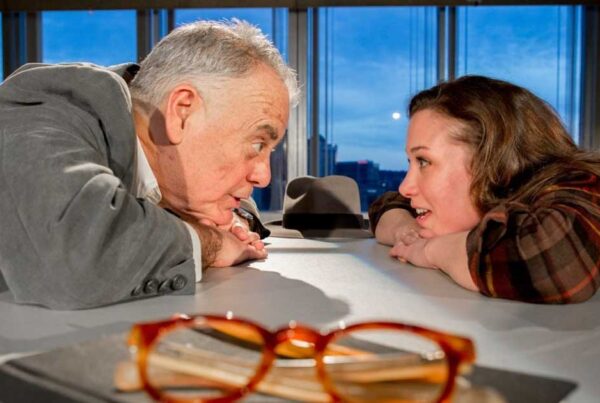
Pittsburgh Post-Gazette – About a third of the way into her narration of recent tumultuous events in her life, the title (and only) character in the play “Ciara” recalls the incantation her recently deceased mob-boss father used to recite to her late at night, to shield her from what he did for a living: “‘I’m taking your eyes,’” he’d say, “’and keeping them safe. I’m taking your ears and keeping them safe.’”
Actor Mary Rawson steeps this moment in nostalgic tenderness, tinged with more than a wee bit of justified resentment. When the Quantum Theatre production opens, Ciara has only just gotten those eyes and ears back, and it’s the bursting of that protective bubble of ignorance that compels her to share her story, which might best be described as a mid-life coming-of-age tale.
Ciara is the owner of a small art gallery in the suburbs of Glasgow, Scotland. Her husband, Bryan, is heir to her father’s criminal empire, a vaguely specified underworld of drug dealing, theft, extortion and graft. She tries to keep her legitimate life and business separate from her husband’s illegitimate (and infinitely more dangerous) activities.
But when Bryan gets embroiled in a conflict with one of her father’s old associates, she comes to understand how deeply her father’s legacy has penetrated and determined her life.
As she lays her tale before us, Ciara uncovers the extent to which she has been a satellite to the world of her father’s and husband’s criminal undertakings, and the unwitting victim of a series of humiliating betrayals. She’s no softie, however, and her purpose is not to throw a pity party but rather to excavate the past in order to move forward.
In playing Ciara, Ms. Rawson gets the character’s mood and tone just right: There’s bitterness here, but it’s wry, cool and distanced, the edgy acerbicness of a woman who has suddenly realized she’s always been on the outside of her life looking in, and has started to come to terms with it.
Ms. Rawson’s Ciara recounts her story in front of a colorful backdrop painted by artist Robert Qualters. Its dominant image is of a drawing, referenced frequently in the play — a mammoth woman lying atop the city of Glasgow. The backdrop contains a confusing riot of other images, too, creating an effect of high-art graffiti befitting the play’s thematic interest in capturing the clash between an underworld culture of crime and poverty and the legit world of nouveau riche art buyers.
As he spools out the story, playwright David Harrower leaves out almost as much as he includes, requiring his audience to add up little hints and bits of information to create the whole. This seems a deliberate choice, mirroring, in the audience, Ciara’s own state of half-knowledge. Like her, we need to piece the story together from overheard conversations and casually dropped hints.
But the tale can feel a little hard to follow at times. In several places, Joseph Seamans’ projections help keep what is a complex sequence of events clear; in others, his images are hard to decipher against the busy backdrop and serve primarily to heighten the narrative ambiguity.
Nonetheless, Mr. Harrower’s writing is highly evocative and engrossing, and he is particularly masterful at using a minimum of words to paint precise and vivid portraits of characters we never see. He has Ciara describe her mother, for example, as “a passing shadow. Scrape of chair, clatter of pan.” The thugs who work for her husband, whom she likes to call “henchladies,” are “three pale interchangeable young men … slim-hipped and sullen.”
And then there is this memorably piquant sketch of Audrey, the wife of the famous artist Ciara is trying to promote to her wealthy clientele, who instantly diminishes the artist’s social cache when she appears with him at his opening: “Beside him, she was an interruption. Soor-faced, serrated.”
“Ciara,” directed by Quantum leader Karla Boos, may be a one-woman show, but with characters so richly described by the playwright and so captivatingly conjured by Ms. Rawson’s commanding performance, it feels like a fully populated and luminously imagined world.




